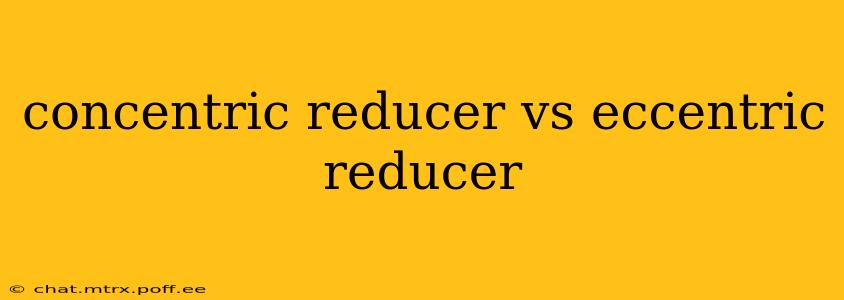Choosing the right pipe fitting can significantly impact your project's efficiency and longevity. When dealing with reducing pipe diameter, the selection often comes down to concentric and eccentric reducers. While both achieve the same fundamental goal – reducing the diameter of a pipe – their design and application differ considerably. This comprehensive guide will delve into the key distinctions between concentric and eccentric reducers, helping you make informed decisions for your specific needs.
What is a Concentric Reducer?
A concentric reducer is a pipe fitting where the centerline of the smaller diameter pipe is perfectly aligned with the centerline of the larger diameter pipe. Imagine two circles, one nested perfectly within the other; that’s the visual representation of a concentric reducer. This symmetrical design is simple and often preferred for its ease of installation and manufacturing.
Advantages of Concentric Reducers:
- Simplicity: Their straightforward design makes them easy to install and understand.
- Cost-Effectiveness: Generally, they are less expensive to manufacture than eccentric reducers.
- Wide Availability: Concentric reducers are readily available from most pipe fitting suppliers.
Disadvantages of Concentric Reducers:
- Potential for Sediment Buildup: In applications carrying liquids or slurries, the sudden change in diameter can cause sediment to accumulate at the reducer's narrower section, potentially leading to blockages.
- Flow Disturbances: The abrupt change in flow area can create turbulence and pressure losses, reducing system efficiency.
- Not Ideal for All Applications: Their design may not be suitable for applications requiring specific flow characteristics or sediment management.
What is an Eccentric Reducer?
An eccentric reducer is a pipe fitting where the centerline of the smaller diameter pipe is offset from the centerline of the larger diameter pipe. This offset design is crucial for specific applications, offering advantages not found in concentric reducers. Think of it as one circle partially overlapping another, with the smaller circle positioned off-center.
Advantages of Eccentric Reducers:
- Improved Sediment Management: The offset design allows for the continuous flow of liquids or slurries even at the smaller diameter, minimizing sediment buildup and blockages.
- Reduced Turbulence and Pressure Loss: The gradual change in flow area minimizes turbulence and pressure drop compared to concentric reducers.
- Ideal for Specific Applications: They are crucial in applications involving liquids with suspended solids or those requiring streamlined flow.
- Maintains a Full Pipe in the Top section: This is particularly important when dealing with liquid flow and preventing air pockets
Disadvantages of Eccentric Reducers:
- Increased Cost: Their more complex design typically results in a higher manufacturing cost.
- More Complex Installation: Installation might require more precision and care compared to concentric reducers.
- Less Widely Available: They might be less readily available compared to their concentric counterparts, especially in some regions or for specialized applications.
Concentric Reducer vs. Eccentric Reducer: Choosing the Right One
The choice between a concentric and eccentric reducer depends heavily on the specific application and its requirements. Consider the following factors:
- Type of Fluid: For liquids with suspended solids or slurries, an eccentric reducer is generally preferred to minimize sediment accumulation. For clean liquids or gases, a concentric reducer might suffice.
- Flow Requirements: If minimizing turbulence and pressure loss is crucial, an eccentric reducer's gradual transition is advantageous.
- Budget: Concentric reducers are generally more cost-effective.
- Installation Complexity: Concentric reducers are easier to install.
Frequently Asked Questions (FAQs)
What are the applications of concentric reducers?
Concentric reducers are widely used in various applications where the flow is relatively clean and simple, such as HVAC systems, compressed air lines, and general industrial piping for gases and clean liquids.
What are the applications of eccentric reducers?
Eccentric reducers are primarily used in applications involving liquids containing suspended solids or slurries, such as wastewater treatment, sewage systems, and chemical processing. They ensure efficient flow even with sediment.
Which reducer is better for wastewater applications?
Eccentric reducers are far superior for wastewater applications due to their superior sediment handling capabilities. The offset design prevents sediment from settling and blocking the pipe.
Can I use a concentric reducer instead of an eccentric reducer?
While you could use a concentric reducer in some cases where an eccentric would be better, it's generally not recommended, especially for fluids containing solids. Doing so might lead to blockages and reduced system efficiency.
What are the different materials used for reducers?
Reducers are available in a wide variety of materials depending on the application and the fluid being conveyed. Common materials include steel, cast iron, PVC, CPVC, and others suitable for specific corrosive fluids.
This guide provides a comprehensive overview of concentric and eccentric reducers, enabling you to select the appropriate fitting for your project. Remember, always consult relevant codes and standards for your specific application to ensure safety and compliance.
